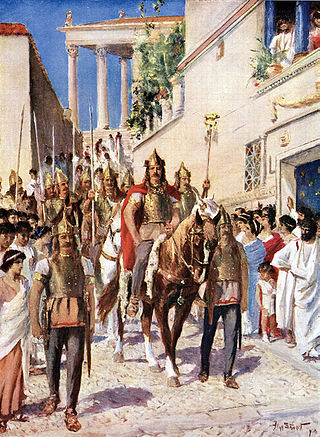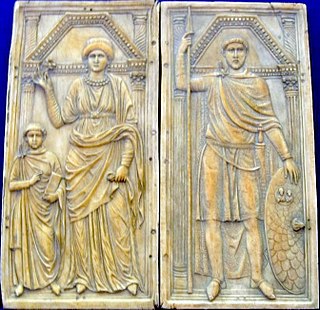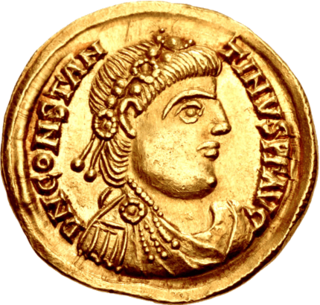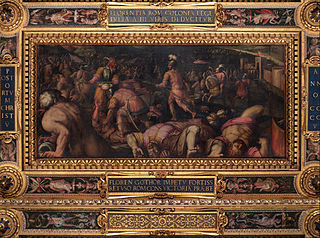Related Research Articles

Alaric I was the first king of the Visigoths, from 395 to 410. He rose to leadership of the Goths who came to occupy Moesia—territory acquired a couple of decades earlier by a combined force of Goths and Alans after the Battle of Adrianople.

Honorius was Roman emperor from 393 to 423. He was the younger son of emperor Theodosius I and his first wife Aelia Flaccilla. After the death of Theodosius in 395, Honorius, under the regency of Stilicho, ruled the western half of the empire while his brother Arcadius ruled the eastern half. His reign over the Western Roman Empire was notably precarious and chaotic. In 410, Rome was sacked for the first time in almost 800 years.
The 400s decade ran from January 1, 400, to December 31, 409.

Magnus Maximus was Roman emperor of the Western Roman Empire from 383 to 388. He usurped the throne from emperor Gratian.

Flavius Valerius Constantius "Chlorus", also called Constantius I, was Roman emperor from 305 to 306. He was one of the four original members of the Tetrarchy established by Diocletian, first serving as caesar from 293 to 305 and then ruling as augustus until his death. Constantius was also father of Constantine the Great, the first Christian emperor of Rome. The nickname Chlorus was first popularized by Byzantine-era historians and not used during the emperor's lifetime.

Stilicho was a military commander in the Roman army who, for a time, became the most powerful man in the Western Roman Empire. He was of Vandal origins and married to Serena, the niece of emperor Theodosius I. He became guardian for the underage Honorius. After nine years of struggle against barbarian and Roman enemies, political and military disasters finally allowed his enemies in the court of Honorius to remove him from power. His fall culminated in his arrest and execution in 408.

Constantine III was a common Roman soldier who was declared emperor in Roman Britain in 407 and established himself in Gaul. He was recognised as co-emperor of the Roman Empire from 409 until 411.

The term Western Roman Empire is used in modern historiography to refer to the western provinces of the Roman Empire, collectively, during any period in which they were administered separately from the eastern provinces by a separate, independent Imperial court. Particularly during the period from 395 to 476 AD, there were separate, coequal courts dividing the governance of the empire into the Western provinces and the Eastern provinces with a distinct imperial succession in the separate courts. The terms Western Roman Empire and Eastern Roman Empire were coined in modern times to describe political entities that were de facto independent; contemporary Romans did not consider the Empire to have been split into two empires but viewed it as a single polity governed by two imperial courts for administrative expediency. The Western Roman Empire collapsed in 476, and the Western imperial court in Ravenna was formally dissolved by Justinian I in 554 AD.

The end of Roman rule in Britain was the transition from Roman Britain to post-Roman Britain. Roman rule ended in different parts of Britain at different times, and under different circumstances. In 383, the usurper Magnus Maximus withdrew troops from northern and western Britain, probably leaving local warlords in charge. In 407, usurper Constantine III took the remaining mobile Roman soldiers to Gaul in response to the Crossing of the Rhine in late 406, leaving the island a victim to barbarian attacks. Around 410, the Romano-British expelled the Roman magistrates from Britain. Roman Emperor Honorius replied to a request for assistance with the Rescript of Honorius, telling the Roman cities to see to their own defence, a tacit acceptance of temporary British self-government. Honorius was fighting a large-scale war in Italy against the Visigoths under their leader Alaric, with Rome itself under siege. No forces could be spared to protect distant Britain. Though it is likely that Honorius expected to regain control over the provinces soon, by the mid-6th century Procopius recognised that Roman control of Britannia was entirely lost.

Constans II was the son of Western Roman emperor Constantine III, and served as his co-emperor from 409 to 411. Constans was a monk prior to his father being acclaimed emperor by the army in Britain in early 407, an act of rebellion against the ruling emperor Honorius. He was summoned to Gaul, appointed to the position of caesar (heir) and swiftly married so that a dynasty could be founded. In Hispania, Honorius's relatives rose in 408 and expelled Constantine's administration. An army under the generals Constans and Gerontius was sent to deal with this and Constantine's authority was re-established. Honorius acknowledged Constantine as co-emperor in early 409 and Constantine immediately raised Constans to the position of augustus (emperor), theoretically equal in rank to Honorius as well as to Constantine. Later in 409 Gerontius rebelled, proclaimed his client Maximus emperor and incited barbarian groups in Gaul to rise up. Constans was sent to quash the revolt, but was defeated and withdrew to Arles. In 410, Constans was sent to Hispania again. Gerontius had strengthened his army with barbarians and defeated Constans; the latter withdrew north and was defeated again and killed at Vienne early in 411. Gerontius then besieged Constantine in Arles and killed him.

The fall of the Western Roman Empire, also called the fall of the Roman Empire or the fall of Rome, was the loss of central political control in the Western Roman Empire, a process in which the Empire failed to enforce its rule, and its vast territory was divided into several successor polities. The Roman Empire lost the strengths that had allowed it to exercise effective control over its Western provinces; modern historians posit factors including the effectiveness and numbers of the army, the health and numbers of the Roman population, the strength of the economy, the competence of the emperors, the internal struggles for power, the religious changes of the period, and the efficiency of the civil administration. Increasing pressure from invading barbarians outside Roman culture also contributed greatly to the collapse. Climatic changes and both endemic and epidemic disease drove many of these immediate factors. The reasons for the collapse are major subjects of the historiography of the ancient world and they inform much modern discourse on state failure.

This is a chronology of warfare between the Romans and various Germanic peoples between 113 BC and 476. The nature of these wars varied through time between Roman conquest, Germanic uprisings and later Germanic invasions of the Western Roman Empire that started in the late second century BC. The series of conflicts was one factor which led to the ultimate downfall of the Western Roman Empire in particular and ancient Rome in general in 476.
Marcus was a Roman usurper who was proclaimed Emperor of Roman Britain. He was killed later that same year in a subsequent mutiny.

Radagaisus was a Gothic king who led an invasion of Roman Italy in late 405 and the first half of 406. A committed Pagan, Radagaisus evidently planned to sacrifice the Senators of the Christian Roman Empire to the gods, and to burn Rome to the ground. Radagaisus was executed after being defeated by the general Stilicho. 12,000 of his higher-status fighters were drafted into the Roman army and some of the remaining followers were dispersed, while so many of the others were sold into slavery that the slave market briefly collapsed. These Goths later joined Alaric I in his conquest of Rome in 410.
The Battle of Pollentia was fought on 6 April 402 (Easter) between the Romans under Stilicho and the Visigoths under Alaric I, during the first Gothic invasion of Italy (401–403). The Romans were victorious, and forced Alaric to retreat, though he rallied to fight again in the next year in the Battle of Verona, where he was again defeated. After this, Alaric retreated from Italy, leaving the province in peace until his second invasion in 409, after Stilicho's death.

The sack of Rome on 24 August 410 AD was undertaken by the Visigoths led by their king, Alaric. At that time, Rome was no longer the capital of the Western Roman Empire, having been replaced in that position first by Mediolanum in 286 and then by Ravenna in 402. Nevertheless, the city of Rome retained a paramount position as "the eternal city" and a spiritual center of the Empire. This was the first time in almost 800 years that Rome had fallen to a foreign enemy, and the sack was a major shock to contemporaries, friends and foes of the Empire alike.
The crossing of the Rhine River by a mixed group of barbarians which included Vandals, Alans and Suebi is traditionally considered to have occurred on the last day of the year 406. The crossing transgressed one of the Late Roman Empire's most secure limites or boundaries and so it was a climactic moment in the decline of the Empire. It initiated a wave of destruction of Roman cities and the collapse of Roman civic order in northern Gaul. That, in turn, occasioned the rise of three usurpers in succession in the province of Britannia. Therefore, the crossing of the Rhine is a marker date in the Migration Period during which various Germanic tribes moved westward and southward from southern Scandinavia and northern Germania.
Heraclianus was a provincial governor and a usurper of the Western Roman Empire (412–413) opposed to Emperor Honorius, who had originally brought him to power. Heraclianus helped put down a rebellion by Priscus Attalus. However, he decided to stage his own rebellion and during his invasion of the Italian peninsula, was either defeated in battle or captured and executed.
Sarus or Saurus was a Gothic chieftain, known as a particularly brave and skillful warrior. He became a commander for the emperor Honorius. He was known for his hostility to the prominent Gothic brothers-in-law Alaric I and Athaulf, and was the brother of Sigeric, who ruled the Goths briefly in 415.

Eucherius was the son of Stilicho, the magister militum of the Western Roman Empire, and Serena, a Roman noblewoman who was the niece of Eastern Roman Emperor Theodosius I. He was born in c. 388 in Rome, Italy. Despite being the son of the magister militum, Eucherius did not rise farther than the modest rank of tribune of the notaries. Stilicho was accused by his political opponents of plotting to install Eucherius as a third emperor in Illyricum, and as a result of this Stilicho was arrested and executed on 22 August 408, and Eucherius soon after.
References
- ↑ Jones, pg. 518
- ↑ Birley, pg. 458
- ↑ Birley, pg. 458
- ↑ Orosius, 7:40:4
- ↑ Burns, pg. 209
- ↑ Burns, pg. 209
- ↑ Birley, pg. 457
- ↑ Bury, pg. 138
- ↑ Zosimus, 6:3:1
- ↑ Bury, pg. 138
- ↑ Bury, pg. 139
- ↑ Burns, pg. 210
- ↑ Burns, pgs. 210-211
- ↑ Stevens, C., Marcus, Gratian and Constantine, Athenaeum, 35 (1957), pp. 320-322
- ↑ Zosimus, 6:2:1
- ↑ Birley, pg. 458; Jones, pg. 519
- ↑ Monmouth, Historia Regum Britanniae, 6:1